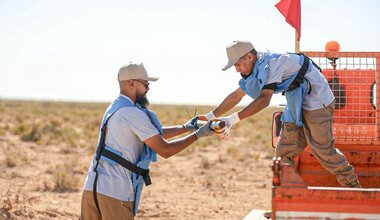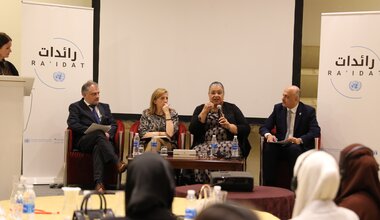For a safer libya: UN, Libyan and International Partners Destroy 50 Tonnes of Ammunition
MISRATA – The preparations took months, the final drag a few hours and in a matter of a few minutes 50 tonnes of explosives went up in smoke, destroyed in two controlled detonations and ridding Libya of dangerous, unstable explosive remnants of war that pose a serious threat to public safety.
These controlled demolition, including unexploded ordnance and ammunition as well other remnants of war that outdated or damaged by weather conditions, are only a fraction of what still needs to be cleared and destroyed in the area of Misrata, a major battleground of the 2011 conflict during the revolution.
These controlled demolitions on 12 December 2013 are the work of teams dedicated to clear areas of the country from this scourge to ensure public safety. Those teams include the Libyan Mine Action Centre, Handicap International, Mine Advisory Group and Danish Church Aid. The United Nations Support Mission in Libya (UNSMIL) coordinated the entire elaborate efforts through its Arms and Ammunition Advisory section.
“We support the operational coordination and ensure that the controlled demolitions are carried out successfully and safely in accordance with the wishes of the Libyans,” said Graeme Abernethy, Chief of Operations of UNSMIL’s Arms and Ammunition Advisory Section who was at the site for the detonations. He added that clearance operations have been going on for many months in that area and the 12 December demolition followed another successful controlled demolition in November.
The importance of ammunition management was stressed again in Resolution 2095 (March 2013), which extended the mandate of UNSMIL. Among its tasks, the Mission was mandated to support Libyan efforts to counter illicit proliferation of arms and related materiel, in particular heavy and light weapons, small arms and man-portable surface-to-air missiles, including through the development of a coordinated strategy in this regard, to clear explosive remnants of
war, conduct demining programmes and conventional munitions disposal, secure and manage Libya’s borders, and implement international conventions on chemical, biological and nuclear weapons and materials, in coordination with the relevant UN agencies, the Organization for the Prohibition of Chemical Weapons, and international and regional partners.
In his report to the UN Security Council on UNSMIL in September 2013, Secretary-General Ban Ki-moon said that unsecured and damaged ammunition, chemical weapons materiel, easily accessible arms, and explosive remnants of war continue to pose a considerable threat to national and regional security. The report added that pursuing a coherent “One United Nations” response, UNSMIL and the United Nations Country Team advised Libyan partners on strategic plans to address the existing landmine and the problem of explosive remnants of war in the country.
Collection of the explosives for the 12 December detonations began in earnest in January. Tonnes upon tonnes of the shells, mortars, rockets and small ammunition were removed from former regime bunkers that were partially or completely destroyed by NATO bombing during the conflict and trucked to a site near the coast 35 kilometres out of Misrata for destruction, said Colonel Mohamed Turjman, from the LMAC/Libyan Army Engineers.
These munitions that were not destroyed by the bombing were rendered unstable and many had littered farming ground near the Air Force Academy, added Turjman, the officer responsible for Mine Action operations for the Central District which includes Misrata, operating under the General Staff Command.
He said that in the Misrata area there are more than 1,000 tonnes of these ordnances and unexploded remnants of war that have been collected. A total of 500 tonnes have already been destroyed and 500 tons more are ready to be destroyed.
Experts expect these amounts to be destroyed on intervals, 50 tonnes a month in two batches of each of the maximum of 25 tonnes, which would mean it will take several months for the process to be completed.
The elaborate process involves a lot of planning, precision and labour.
Approximately 40 people from various partner Explosive Ordnance Disposal teams involved, helped provide the labour and equipment to move and unload safely. It took three to four days to prepare for the 12 December demolition, with bulldozers digging two square pits of about 10 metres long by 10 metres wide with about three metres deep.
Then on the day of the detonation, in a matter of hours, the remnants of war to be destroyed were trucked from the storage area to the site under guard, placed in rows in the pit – large caliber on the outside and smaller caliber on the inside - several layers on top of each other, each layer surrounded and covered by sandbags to assist in complete detonation and to prevent the ordnance from dispersing. Land mines were laid to simultaneously explode with controls wired to a safe distance of about two kilometres away. Each pit should not hold more than 25 tonnes, the maximum allowed for safety reasons.
At midday, after radio communication between the various teams signaled that they were ready, Colonel Turjman gave the go ahead and within seconds a strong explosion sent black smoke billowing sky high. Thirty minutes later, another explosion destroyed the other 25 tonnes in another nearby pit.
Shortly afterwards, teams visually inspected the sites of the detonations which dug a 10-metre deep, 40-metre-wide hole in the sand, for any remaining unexploded remnants before a bulldozer moved in and leveled the ground.
The detonations are only part of what the UN is doing on arms and ammunition control.
After the 28 November 2013 explosions which killed more than 40 people in the southern Libya ammunition depot at Brak Al-Chati, detonations accidentally caused by looters, the UN sent a team of experts to the area to advise on how to deal with the disaster.
In July 2013 in Misrata, the UN built the first such storage area for ammunition which can take up to 400 tonnes was inaugurated in Misrata. UNSMIL, through the United Nations Mine Action Service (UNMAS) in September trained and equipped a Libyan Air Defence unit on how to deal with an emergency resulting from leaking liquid rocket fuel and how to neutralize corroded or partially destroyed rocket fuel containers.
Samir F. Ghattas
------------------------------------------------------------------------
UNSMIL Public Information & Communication Office
 United Nations Peacekeeping
United Nations Peacekeeping UN
UN






















